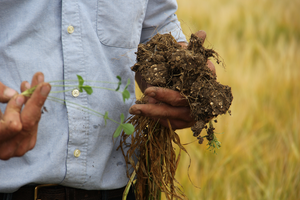For the first time in history, the City of Austin declared municipal water as unsafe for consumption two weeks ago. The resulting fallout left shockwaves across the entire city while also uniquely affecting each and every Austin resident. While flash floods are not a new challenge for our community, the recent water conditions have affected the local economy, the health of citizens, and the landscapes of our beautiful city in previously unimaginable ways.

While Austinites felt the greatest effects of heavy Central Texas rain, the majority of flash flooding and consequential water contamination can be traced back to the surrounding Hill Country farms and ranchlands where our food is grown. Most of our local farmlands are characterized by lifeless, compacted soil that has been severely degenerated due to decades of conventional management. When soil is in this state, rainwater is unable to infiltrate the ground, which can result in flash flooding.
It takes nature up to 500 years to build one inch of topsoil, but pockets of farmland in the Texas Hill Country lost twice that amount within a week of flooding. In our recent water crisis, the smallest particles of eroding soil (silt and clay) entered our systems and clogged the filters of our city’s water treatment plants. This ecological time bomb is exasperated each time a farmer tills his field, a rancher overgrazes his pasture, or a rural landscape is left bare.
In a report issued by the Food and Agriculture Organization of the United Nations, we only have around 60 years of food production left at the current rate of soil loss before our agricultural system collapses. When observed holistically, the health of our soil is directly connected to the health of our bodies and the health of our ecosystems. While the collapse of our soil’s life-giving force is alarming, it shouldn’t be surprising. There have been over 22 documented world civilizations that have vanished practicing the same erosive and degenerative forms of agriculture that we currently refer to as “sustainable.” If we wish to reverse these trends and defend the health of our communities, we must start by defending the health of our soil.

Thankfully, a growing community of Central Texas food producers are taking it upon themselves to become a part of the solution. Through land management practices such as no-till seeding, the use of cover crops, and the implementation of rotational planned grazing, area farmers are building critical soil health. Healthy soil helps prevent flash flooding, grows nourishing foods, sequesters carbon, and fills our aquifers. This agricultural revolution is known as “regenerative,” and it’s the most promising tool to ensuring the continued prosperity of our civilization. If we wish to have a food system that builds resilience, heals our land, and enriches the health of our neighbors, consumers need to support farmers and ranchers practicing regenerative agriculture.
In the wake of our recent water crisis, it’s clear that now—more than ever—that we need to unite and support an agricultural system that regenerates, restores, and heals our soil. Let’s keep our Hill Country rivers running clear, our landscapes thriving with green-growing plants, and our communities well-nourished.



